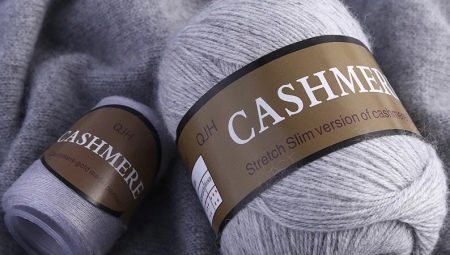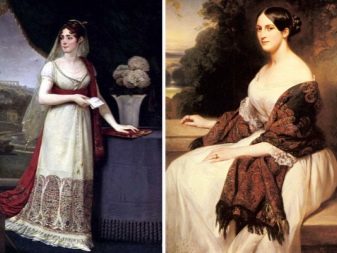All About Cashmere Yarn

An unusually warm, but at the same time airy and almost weightless fabric is made from the highest quality down, which has always been expensive. In Europe, shawls from the Himalayan principality of Kashmir appeared thanks to Napoleon, who brought an expensive gift to Josephine.
Products made from the finest goat down for several decades do not lose their qualities, remaining all the same beautiful, warm and elastic, as immediately after production.


Description
For many centuries, products made using cashmere yarn have remained a symbol of great wealth and a certain social status. Real cashmere, known since the XII century, learned to spin the peoples inhabiting the Tibetan highlands, located on the territory of 3 countries - Pakistan, India and China. The goats living there, due to the unique climatic features of the region, are overgrown with especially thin, long and light wool. Attempts to breed such goats in other areas have shown that animals quickly lose these properties of their fleece, if they do not experience the same sharp and large temperature changes as in their homeland.

In the spring, the fluff is combed out from goats, in which the molting period begins. The thick undercoat is the finest fiber, in comparison with which human hair is 3 times thicker and coarser. All work on collecting down is carried out only by hand, using special combs, like many centuries ago. One animal manages to get no more than 200 grams of expensive material, and this is only 1/3 of the shawl.


To obtain the result in the form of expensive yarn, natural wool is processed, spun, dyed by hand and in small batches. Large labor costs for producing light and warm cashmere yarn explain its high cost, but the owner of a product made from such yarn will be able to appreciate its unique properties, including such.
- Very light weight - a shawl weighing about 0.5 kg can be so thin that it can be threaded into the ring from the finger.
- Despite the fineness of the threads, cashmere has low thermal conductivity.
- The fibers of the goat hair yarn turn out to be thinner and softer than silk.
- In products made from cashmere yarns dust mite won't starttherefore they do not cause allergies.
- Wear resistance and extraordinary strength cashmere put it on a par with silk and wool.
- Pilling on cashmere products only in places of close contact of things and long-term wear.
- In natural wool fibers contains wax that gently cares for the skin.
It has been noticed that cashmere fabrics have a good effect on the spine and sore joints, warming them up and reducing pain.


Overview of varieties
Currently, specialists from Italy and Scotland are considered the best producers of natural cashmere yarns, who were able to create the appropriate conditions for raising suitable breeds of goats in the mountainous regions, as well as learn how to properly handle and produce thread from their rich undercoat. The finest hair of goat fluff is found, having a thickness of less than 15 microns - this is the most expensive type of yarn, called pashmina. It is used to make the most expensive knitted items and luxury fabrics.
The next variety of coarser wool fibers is called semi-pashmina. It is widely used for the production of various warm fabrics and all kinds of knitwear. About 10% of natural wool yarn always consists of a silk warp, which gives the garment its strength and elasticity. The most refined of the cashmere yarns is the worsted knitting yarn. When you receive it, all hairs are brushed by hand, and non-standard ones are immediately removed.



Possible formulations
The composition of cashmere fabrics can be different, and the addition of different fibers from other origins affects the quality of the starting material. Various additives increase the wear resistance, color brilliance or elasticity of the wearable. Yarn, which claims to be 100% cashmere, is rarely found on the market, since its cost is very high and starts at $ 100 per 1 kilogram. At a lower selling price, the buyer should inquire about the authenticity of the product. A significant reduction in the cost of cashmere products or threads is possible when it comes to 10, 20, 30, 50 or 90 percent additives consisting of natural or man-made fibers.

The production of mixed types of fabrics from natural cashmere does not impair its qualities, but often improves many characteristics of the products. The type and purpose of things are often guided by the type of such additives. Light scarves, blouses or thin shawls are best created from a mixture of expensive wool and silk.
Such things belong to the category of elegant, have a luxurious shine, but are unstable to frequent use, quickly losing the splendor of their appearance.


The combination of cashmere with angora gives a thin and delicate knitwear, from which womens jumpers, cardigans and thin but warm sweaters are made. For children who are not allergic to wool, knit socks, hats and other types of clothing. It is possible to prolong the good appearance of expensive products, provided that certain rules of wearing and care are observed.Men often do not have enough time to pay attention to such subtleties when using things for every day, so capricious cashmere for the manufacture of men's jackets or jumpers is combined with the wool of other animals, for example, a camel or a llama. This makes sweaters denser and tighter, and warms up much better than ordinary sweaters.


For knitting socks, gaiters and other products for everyday use, natural cashmere wool is combined with cotton, acrylic, nylon or microfiber. This allows you to extend the service life of warm clothes, as well as to make their colors as diverse as possible. Pilling almost does not occur on the surface, even with conventional washing methods, and they do not change their original shape for a long time.

Top manufacturers
When choosing high-quality cashmere yarns, you can rely on world-renowned brands specializing in the production of the highest quality natural yarns. An Italian company can become such a guarantee for the buyer. Lana Grossa, designer yarns from the brand Debbie bliss and English wool, produced by the company Rowan.
The breeding of unique goats and yarn manufacturers from China did not bypass their attention. Currently, there are many Chinese wool products on the market, but the quality of the products is in a wide range. In this case, you can trust reliable trade organizations that check the quality of goods.



Selection Tips
The annotations for each finished product or skein of yarn indicate the percentage of expensive goat wool to additives. The higher the percentage of cashmere in the produced threads or fabrics, the more the expected qualities of an expensive product can be found in them. If you buy fabrics with less than 50% cashmere at too high a price, you can expect that the effect of the unique fibers will be weak.
Outwardly, products made from expensive cashmere yarn look quite simple, their value is not in flashy design or exquisite cut. They gained popularity with completely different properties, which remain characteristic of natural, high-quality products with a high content of mountain goat down. The feeling of comfort, warmth and coziness can be felt in the simplest-looking blouse or sweater. However, when choosing cashmere items, you should pay attention to the authenticity of the materials and prepare for the peculiarities of caring for such items.
Especially delicate should be handled things made of gauze or thin knitted fabric.



Calculation taking into account the knitting method
The usual and simple way to determine the amount of yarn for a product is to calculate according to the selected hand knitting pattern. On sale cashmere yarn is sold in skeins of 50 and 100 grams, but due to its fineness, up to 700 meters of thread can be placed in one skein. To knit thick things with knitting needles, the threads will have to be folded several times, from 3 to 6, which will reduce the total length of the skeins.
For a more accurate calculation, you need to knit a sample of 10 loops for 10 rows, and then measure how many turned out in centimeters... After loosening the sample, you need to measure the piece of yarn that was consumed on it. So you can find out what area of the knitted fabric is obtained from the length of one skein, and calculate how many of them are required for the entire product.









